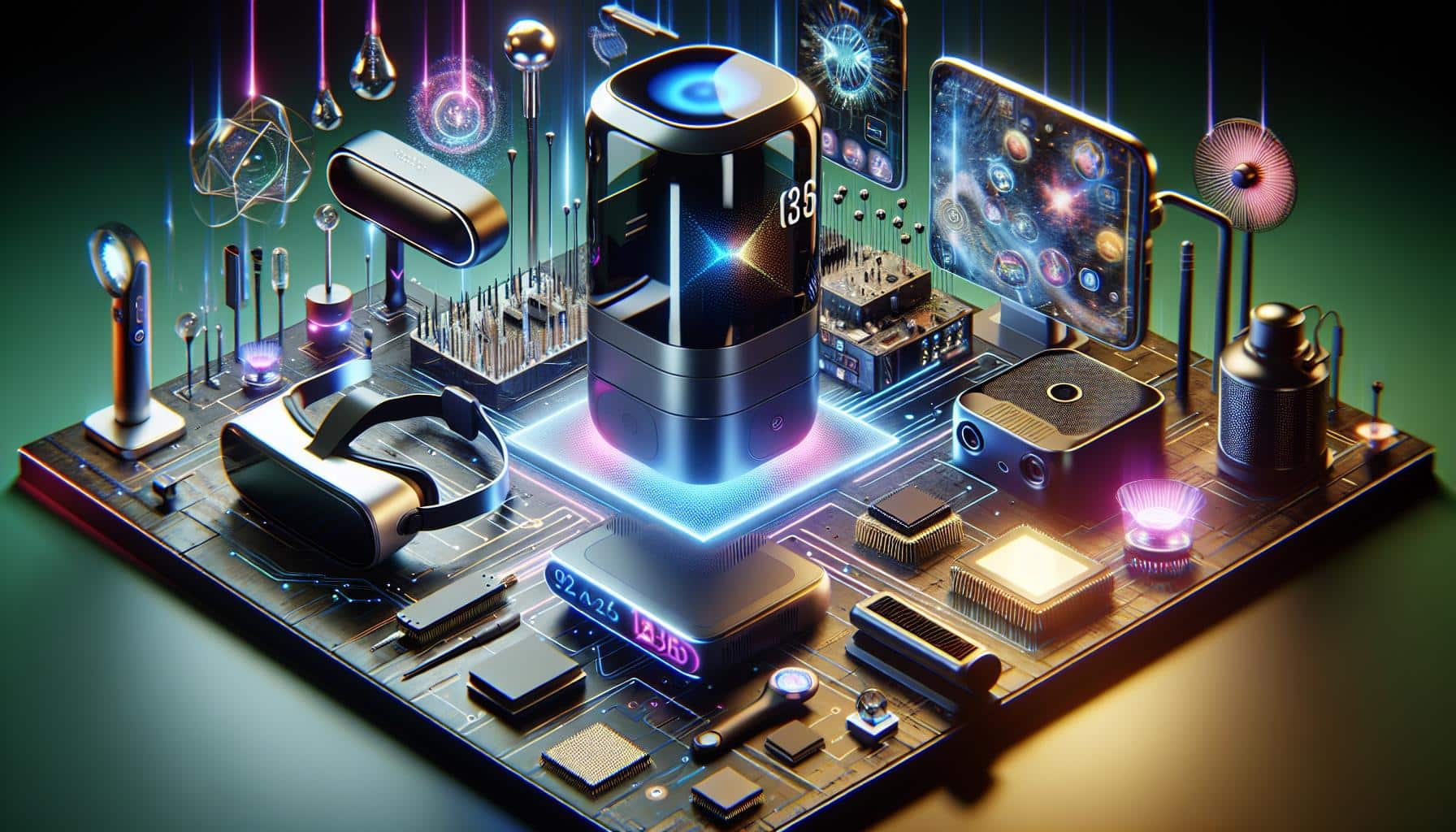Sony Announces New High-Quality XR Head-Mounted Display at CES 2024
At CES 2024, Sony made a significant announcement in the field of augmented and virtual reality headsets, showcasing their new high-quality XR head-mounted display. As a well-established player in the headset market with their PlayStation VR headset, Sony aims to take a step further with this new offering.
The yet-to-be-named headset is a standalone device that features 1.3-inch 4K OLED microdisplays. It allows users to view their environment through a see-through function enabled by six external cameras and sensors. With a ring controller for object manipulation and a pointing controller for precision work, the headset offers a seamless interaction with 3D objects.
Powered by Qualcomm’s Snapdragon XR2+ Gen 2 Platform and Sony’s proprietary rendering technology, the headset is capable of real-time realistic rendering of 3D objects and facial expressions of human characters. Unlike Sony’s PlayStation VR, this headset is primarily designed for content production, including 3D model creation and modification in virtual or mixed-reality environments.
Sony plans to launch this new headset sometime in 2024, providing competition for Apple’s upcoming Vision Pro. With its impressive features and focus on content creation, Sony aims to attract professional users and enthusiasts looking for a powerful and immersive AR/VR experience.
Introducing Asus AirVision M1: Smart Glasses for Virtual Screens
Asus showcased its latest innovation, the AirVision M1 wearable display, at CES 2024. Although not strictly a VR or mixed-reality headset, the AirVision M1 falls under the category of smart glasses. Designed to enhance productivity and create virtual screens, these glasses feature a micro OLED display with a 1080p resolution for each eye.
The AirVision M1 provides users with a wide field of view, surpassing natural vertical viewing angles, making it suitable for various applications. Through its multi-function touchpad and three degrees of freedom, users can set up multiple virtual screens around them and switch between displays effortlessly. The glasses are connected to a host device via a USB Type-C connection, which enables them to function as a video output.
Moreover, the AirVision M1 includes features like noise-canceling microphones and speakers, enhancing remote conferencing capabilities. While pricing and availability details have not been confirmed by Asus, these smart glasses offer a promising alternative for users seeking a productive and immersive virtual screen experience.
Xreal Unveils Second-Generation Air 2 Ultra AR Glasses at CES 2024
Building upon the success of their original Air AR glasses, Xreal made waves at CES 2024 with the introduction of the second-generation models. Among these, the Xreal Air 2 Ultra stands out, offering an enhanced experience for users interested in spatial computing.
The Ultra version features full positional tracking with six degrees of freedom, facilitated by dual 3D cameras that map the user’s environment and enable gesture recognition. Each eye is equipped with a high-resolution Sony micro OLED panel, providing a 1080p resolution and a 120Hz refresh rate. The glasses also offer a wide field of view of 52 degrees and switch between three dimming levels for improved immersion.
Xreal has positioned the Air 2 Ultra primarily as a developer-focused product rather than targeting the general public. With a price tag of $699, the glasses are available for pre-order, with shipments expected by the end of March.
Qualcomm Launches Snapdragon XR2 Gen 2 Chipset for Improved MR and VR Experiences
Qualcomm, a leading provider of mobile chipset technology, made a significant announcement at CES 2024 with the launch of their Snapdragon XR2 Gen 2 platform. This new chipset aims to power next-generation augmented and virtual reality headsets, promising improved mixed reality (MR) and virtual reality (VR) experiences.
The Snapdragon XR2 Gen 2 platform offers a 15% higher GPU frequency and 20% higher CPU frequency compared to its predecessor. This boost enables the chipset to support resolutions of up to 4.3K per eye when combined with compatible hardware. Additionally, the new chipset demonstrates an eight-fold improvement in AI performance compared to the previous generation.
Furthermore, Qualcomm has partnered with Samsung and Google to leverage the Snapdragon XR2+ Gen 2 platform in their upcoming hardware releases. Samsung and Google are expected to develop their own headsets utilizing the advanced capabilities of Qualcomm’s chipset.
To demonstrate the power of the Snapdragon XR2 Gen 2 platform, Qualcomm also collaborated with Goertek to create their own VR and MR reference design, incorporating Tobii eye-tracking technology. This joint effort showcases the potential for innovative and immersive experiences powered by Qualcomm’s latest chipset.
No Sudden Competition for Apple Vision Pro at CES 2024: A Closer Look at the Headset Field
With the imminent release of the Apple Vision Pro, CES 2024 emerged as the last major opportunity for competing AR and VR headset manufacturers to make an impression. However, none of the showcased devices posed any immediate threat to Apple’s dominance in the headset market.
Sony’s high-quality XR head-mounted display, while impressive, is primarily aimed at content production rather than consumption by the general public. The headset’s focus on developers and its specific use case differentiates it from Apple’s upcoming device.
Similarly, the Asus AirVision M1 smart glasses target virtual screen creation and productivity rather than providing an immersive mixed-reality experience. Though innovative, they cater to a different user segment compared to Apple’s Vision Pro.
Xreal’s Air 2 Ultra AR glasses excel in offering spatial computing features and developer-centric capabilities. However, they align more closely with Microsoft’s HoloLens in terms of functionality, rather than directly rivaling Apple’s mixed-reality headset.
Even the introduction of Qualcomm’s Snapdragon XR2 Gen 2 chipset and its partnerships with Samsung and Google go hand-in-hand with future hardware releases, which are still months away from reaching consumers.
While CES 2024 showcased several compelling AR and VR devices, none posed an immediate challenge to Apple’s Vision Pro. Apple’s foray into the headset market remains highly anticipated, and it will be interesting to observe how the industry develops in the coming months.
Analyst comment
Positive news: Sony Announces New High-Quality XR Head-Mounted Display at CES 2024
As an analyst, I predict that Sony’s new XR head-mounted display will have a positive impact on the market. With its impressive features and focus on content production, it will attract professional users and enthusiasts looking for a powerful and immersive AR/VR experience. It will also provide competition for Apple’s upcoming Vision Pro.
Positive news: Introducing Asus AirVision M1: Smart Glasses for Virtual Screens
The Asus AirVision M1 smart glasses offer a promising alternative for users seeking a productive and immersive virtual screen experience. While not strictly a VR or mixed-reality headset, these glasses are designed to enhance productivity and create virtual screens, making them suitable for various applications. They will likely find a market among users looking for a new way to enhance their productivity.
Neutral news: Xreal Unveils Second-Generation Air 2 Ultra AR Glasses at CES 2024
The second-generation Xreal Air 2 Ultra AR glasses offer an enhanced experience for users interested in spatial computing. With a focus on developers, these glasses are not targeting the general public. While they offer impressive features, they align more closely with Microsoft’s HoloLens than directly rivaling Apple’s Vision Pro. Their impact on the market is uncertain.
Positive news: Qualcomm Launches Snapdragon XR2 Gen 2 Chipset for Improved MR and VR Experiences
Qualcomm’s launch of the Snapdragon XR2 Gen 2 platform is positive news for the market. This new chipset promises improved mixed reality (MR) and virtual reality (VR) experiences, with higher GPU and CPU frequencies and improved AI performance. The partnerships with Samsung and Google to utilize the chipset in their upcoming hardware releases further demonstrate its potential impact.
Neutral news: No Sudden Competition for Apple Vision Pro at CES 2024: A Closer Look at the Headset Field
Despite showcasing several compelling AR and VR devices at CES 2024, none













